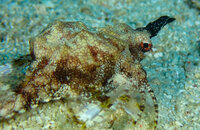For TTL, I believe you will need a camera and strobe with electrical connections. The octo housing only has optical so I don't think you can use TTL.
An electrical sync connection is neither required nor, by itself provides TTL flash functionality. Each camera manufacturer - Canon, Fujifilm, Nikon, Olympus/Panasonic, Sony - has their own TTL protocol, which is used for bidirectional communication between camera and flash. On land, this means you need brand-specific strobes and/or radio triggers. Underwater, this means brand-specific TTL-capable triggers, which come from a number of manufacturers - Sea & Sea and Ikelite offer such solutions for their housings, while TRT Electronics offer a housing-agnostic option, and UW-Technics sell a large variety of SKUs fitting different housings. These triggers can output optical or electrical signals, or, in some cases, both.
Some strobes, notably Seacam and OneUW, have the TTL circuits built into the strobe. This requires electrical connectivity to function, and in case of Seaflash 150D and OneUW 160X, uses separate models to support Canon and Nikon cameras. The newer Seaflash 160D can switch between Canon and Nikon on the same model.
Optical TTL can work off a camera's built-in/pop-up/clip-on flash, with the caveats that this flash supports TTL operation itself (these days, it's almost a given) and that it exists to begin with - most higher end cameras don't have a built in flash - and fits the housing; for example, Olympus has a little FL-LM1 flash, and some housings come with a big hump on top that fits it, but the popular AOI E-PL10 housing opts for a more compact layout and that flash does not fit in there.
Drawbacks of using a flash, rather than an LED trigger, to operate underwater strobes include increased drain on camera batteries, slower recycle time, and a hard cap on top-end output - most built-in flashes don't flash for over 1ms or so, whereas underwater strobes generally take around 3ms for a full dump, more for circular-bulb models.
Note that the included triggers in AOI housings are manual-only, and thus do not offer any TTL functionality. Any strobes that you shoot with them must operate in manual mode with optical input, and TTL-only strobes such as YS-03 are not usable. Electrical-only strobes such as Ikelite DS51, DS125 and DS160 require an optical-to-electric converter, such as the Ikelite RC1. Note that while this converter supports TTL operation, it still needs a TTL source, so with a manual trigger driving it, it will still be manual-only.
Another caveat with TTL is that it is not always accurate. Some cameras and triggers do it better than others, and some strobes have a limited range in which they can be controlled via TTL. For example, I was told that the original Retra strobe (the one with straight bulb) is near-useless with regard to TTL, although the newer circular-bulb models are better in this regard.




